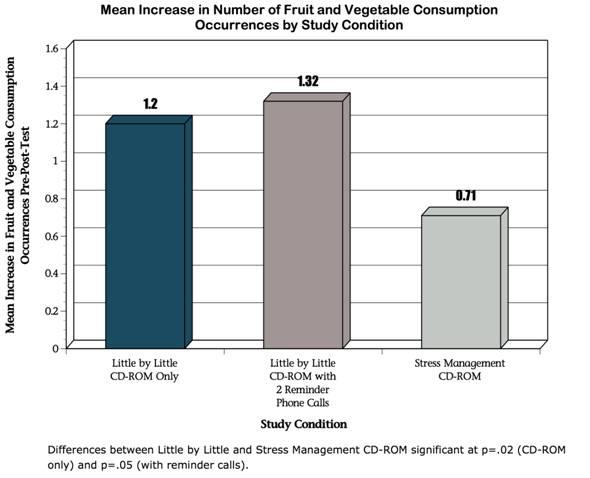Program Synopsis
Designed to increase fruit and vegetable consumption among low-income African American and White women, this intervention is an interactive CD-ROM (with optional reminder calls) that includes a questionnaire on dietary habits, feedback on the need for change, modules on how to make dietary improvement, and suggestions for goal setting. The study showed an increase in fruit and vegetable consumption.
Program Highlights
Program Materials
Preview, download, or order free materials on a CD
Program Scores
The Need
Research indicates that low fruit and vegetable intake is a risk factor for many chronic diseases. A majority of Americans eat fewer than the recommended daily number of servings of fruits and vegetables. Most interventions aimed at increasing fruit and vegetable consumption have produced only small changes. More successful interventions have been costly and staff-intensive. Little by Little is a single-use brief interactive CD-ROM that has been successful in increasing fruit and vegetable consumption in a low-income population.
The Program
The Little by Little intervention is a single brief experience with an interactive CD-ROM. The CD-ROM was developed for English-speaking adults. Usability was tested with an ethnically diverse sample of men (30.2%) and women (69.8%) with an age range from under 20 to over 70; 24.2% had an annual income of under $20,000. The program includes a 10-item questionnaire on usual intake of fruits and vegetables and a 15-item questionnaire on fats and snacks, immediate feedback regarding need for change, modules on how to make dietary improvement, and suggestions for goal setting. Users are encouraged to choose one or two goals and try them for two weeks. The CD-ROM may be used alone or in conjunction with reminder calls. Interviewers making reminder calls ask participants if they remember the goals they set, how well they have progressed toward the goals, and if they have had any problems reaching the goals.
Time Required
The median length of time required to complete the fruit and vegetable components of the program is 12 minutes. No training is required before sharing the CD-ROM with participants, but a staff member should set it up the first time. The program developer reported more effective results when reminder calls were made. Two brief telephone calls were made to the participant within the subsequent two month period, in which the interviewer asked questions regarding their personal goal and if they had remembered the goal and if they had accomplished the goal.
Intended Audience
Participants in the randomized trial were low-income African-American and non-Hispanic white women who were English speaking adults.
Suitable Settings
The intervention is intended for use in public health and clinical settings, e.g. primary care practices.
Required Resources
The CD-ROM is required. Programs can also incorporate a call to participants from staff members reminding them of goals they set during the CD-ROM exercise.
About the Study
A randomized placebo-controlled trial with 481 low-income African-American and non-Hispanic white women compared: 1) a single experience with the computer-based "Little by Little" program, 2) the Little by Little computer-based program experience with two reminder phone calls, and 3) a non-dietary CD-ROM, "Stress Management: A Healthy Balance", which lasted 15-20 minutes. Participants ranged in age from 40-65 years. They provided 24-hour recall data on dietary intake at baseline and two months after the CD-ROM interaction.
Key findings include:
- The Little by Little group with reminder phone calls increased fruit and vegetable consumption by 1.32 occurrences per day compared with 0.71 occurrences in the stress reduction group (p=.02).
- The Little by Little group with no reminder phone calls increased fruit and vegetable consumption 1.20 occurrences per day, also significantly greater than the stress reduction control group (p=.05).

- Among those with a high school education or less, the group receiving reminder phone calls increased its number of servings of fruits and vegetables and consumed more than the stress reduction intervention (p=.01).
- Among those with more than a high school education, no statistically significant differences were observed in servings of fruits and vegetables consumed in either of the Little by Little groups relative to the stress-reduction group.


